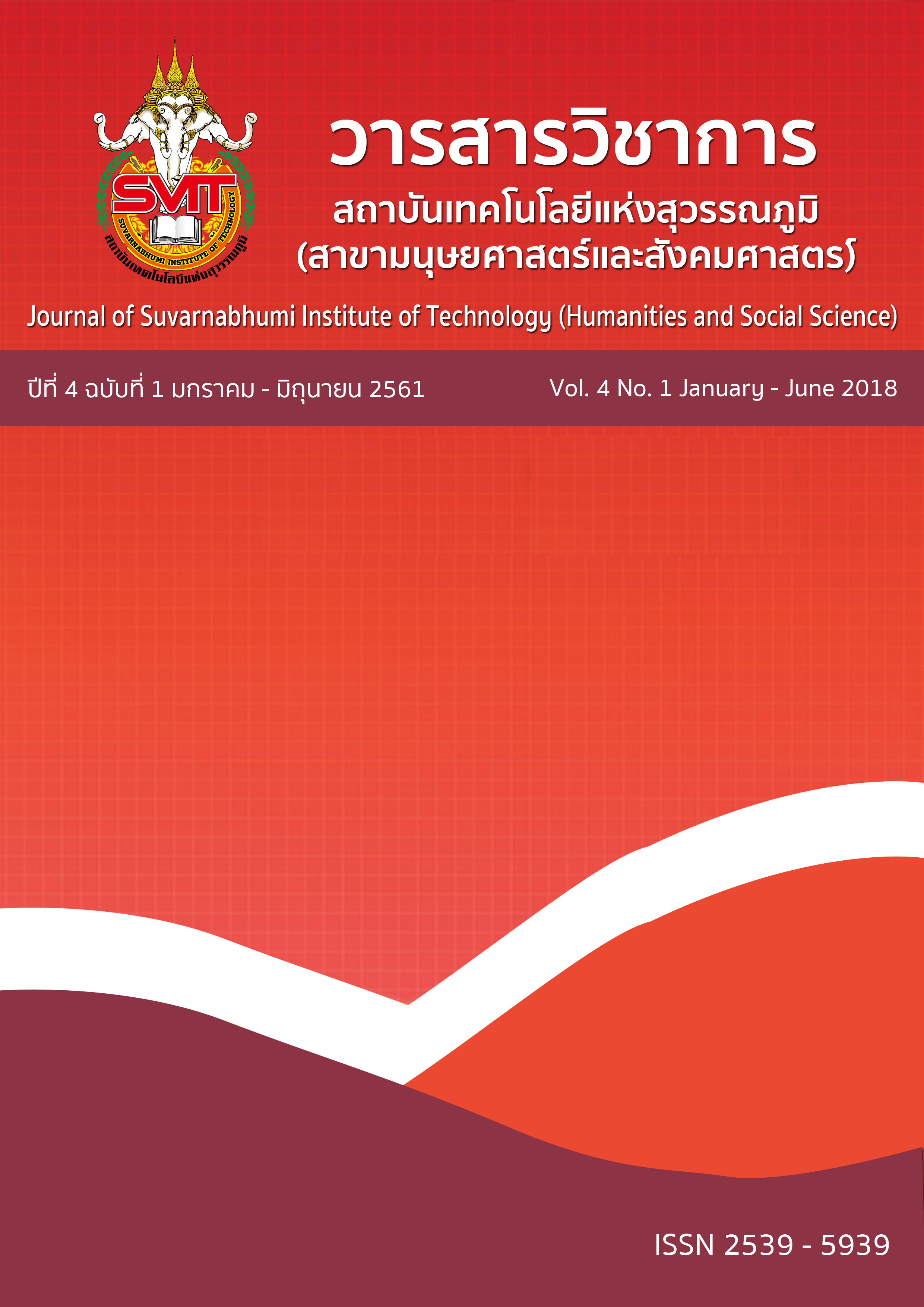INTERNAL BRANDING AND COMMUNICATION ON BRAND SUPPORTING BEHAVIOURS OF EMPLOYEES OF PRIVATE ORGANIZATION INVADING ASEAN MARKET
Keywords:
Internal Branding, Brand Communication, Brand Supporting BehaviorAbstract
The objectives of this research are to understand the definition and meaning of , as well as to find psychological and social causative conditions of internal branding, brand communication, and brand supporting behaviors of employees of a private organization invading ASEAN market. The methodology is a qualitative case study of 2 companies, one is the Thai Beverage Public Company Limited which runs a production business, the other is the Supamitr Hospital Public Company Limited which runs a service business. The researcher performed in-depth interviews with 23 employees from executive, human resource, marketing, and branding and brand communication sections. Results are divided into 5 parts. 1) understanding that the definition and meaning of branding and brand communication are the formation of thrust and perception on internal branding, vision, mission, policies, and values among employees. 2) All employees are responsible for the formation of internal branding. Executive administrators have to set up policies. The process of brand formation comprises of orientation, training, group discussion, summarizing, and reviewing. The process of brand communication comprises of internal communication, marketing communication, and positive word of mouth. 3) Causative conditions for brand formation and brand communication are employee satisfaction in 2 aspects. i.e., social aspect, which are working environment and perception of organization support, and psychological aspect, which is motivation to work. 4) Brand supporting behaviors of employees have 2 aspects, i.e., attitudes and behaviors. Attitudes comprise of brand identity, brand commitment, and brand loyalty. Behavioral aspect is brand performance. 5) As to policies into ASEAN market, organizations use 2 patterns of policy. Active policy goes to other ASEAN countries to run business while passive policy runs business to serve ASEAN customers that come to Thailand.
References
ชาย โพธิสิตา. (2556). ศาสตร์และศิลป์แห่งการวิจัยคุณภาพ.กรุงเทพมหานคร: อมรินทร์พริ้นติ้งแอนด์พับลิชชิ่ง
นริสรา พึ่งโพธิ์สภ, ฐาศุกร์ จันประเสริฐ, ดุษฎี โยเหลา และเชาวนี แก้วมโน.(2559) การรับรู้ภาพลักษณ์แบรนด์ การสร้างแบรนด์ภายใน และความยึดมั่นด้านความรู้สึกต่อแบรนด์องค์กรของบุคลากรในมหาวิทยาลัย. วารสารพฤติกรรมศาสตร์เพื่อการพัฒนา 8(2), 71 – 92
ปิ่นปินัทธ์ สัทธรรมนุวงศ์ (2558). กลยุทธ์การสื่อสารเพื่อสร้างพนักงานเป็นแบรนด์องค์กร. (ดุษฎีนิพนธ์ปรัชญาดุษฎีบัณฑิต). มหาวิทยาลัยนเรศวร.
พิชากร ว่องวิชญกร.(2553). กลยุทธ์การสร้างตราสินค้าภายในองค์กรและพฤติกรรมของพนักงาน (วิทยานิพนธ์ปริญญามหาบัณฑิต). จุฬาลงกรณ์มหาวิทยาลัย, คณะนิเทศศาสตร์, สาขาวิชาการโฆษณา
วีรพงษ์ พวงเล็ก, นริสรา พึ่งโพธิ์สภ และดุษฎี โยเหลา. (2561) วิธีการสร้างแบรนด์และผลของการสร้างแบรนด์ภายในองค์กรของสถาบันอุดมศึกษาในเขตกรุงเทพมหานคร. วารสารพฤติกรรมศาสตร์เพื่อการพัฒนา 10 (1) 104-125
วรางคณา งาคู่ปฏิพัทธ์ และคณะ (2550). กลยุทธ์การสร้างแบรนด์ให้กับนายจ้าง (Employer Branding) โดยเฉพาะมุมมองด้านการสรรหาพนักงาน กรณีศึกษา บริษัท เจริญโภคภัณฑ์อาหาร จำกัด (มหาชน) คณะพาณิชยศาสตร์และการบัญชี มหาวิทยาลัยธรรมศาสตร์
ศิริยุพา รุ่งเริงสุข (2551) การสร้างแบรนด์ลูกจ้าง (ให้ช่วยสร้างแบรนด์นายจ้าง) สืบค้นจากhttp://shine-management-tips.blogspot.com/2008/02/blog-post_8782.html
ศิระ ศรีโยธิน (2560). การสร้างแบรนด์ภายในองค์กร และความได้เปรียบในการแข่งขัน. Veridian E-Journal, Silpakorn University. 10(2). 1011 - 1024
เสริมยศ ธรรมรักษ์.(2550). การสร้างแบรนด์ภายใน: ดูแลบุคลากรก่อนใส่ใจลูกค้า. วารสารนักบริหาร, 30(2), 21-29
Davis, S. M., & Dunn, M. (2002). Brand assimilation: Aligning employees around your brand. Retrieved April 23, 2010, from http://www.prophet.com/downloads/ whitepapers/BrandAssimff.pdf
de Chernatony, L., & Segal-Horn, S. (2001). Building on services’ characteristics to develop successful services brands. Journal of Marketing Management, 17, 645-669Davis; & Dunn. 2002
Punjaisri, K., Evanschitzky, H., & Wilson, A. (2009). Internal branding: An enabler of employees’ brand-supporting behaviours. Journal of Brand Management, 20(2), 209-226
Downloads
Published
Issue
Section
License
บทความที่ได้รับการตีพิมพ์เป็นลิขสิทธิ์ของวารสารวิชาการ สถาบันเทคโนโลยีแห่งสุวรรณภูมิ
ข้อความที่ปรากฏในบทความแต่ละเรื่องในวารสารวิชาการเล่มนี้เป็นความคิดเห็นส่วนตัวของผู้เขียนแต่ละท่านไม่เกี่ยวข้องกับสถาบันเทคโนโลยีแห่งสุวรรณภูมิ และคณาจารย์ท่านอื่นๆในสถาบันฯ แต่อย่างใด ความรับผิดชอบองค์ประกอบทั้งหมดของบทความแต่ละเรื่องเป็นของผู้เขียนแต่ละท่าน หากมีความผิดพลาดใดๆ ผู้เขียนแต่ละท่านจะรับผิดชอบบทความของตนเองแต่ผู้เดียว





